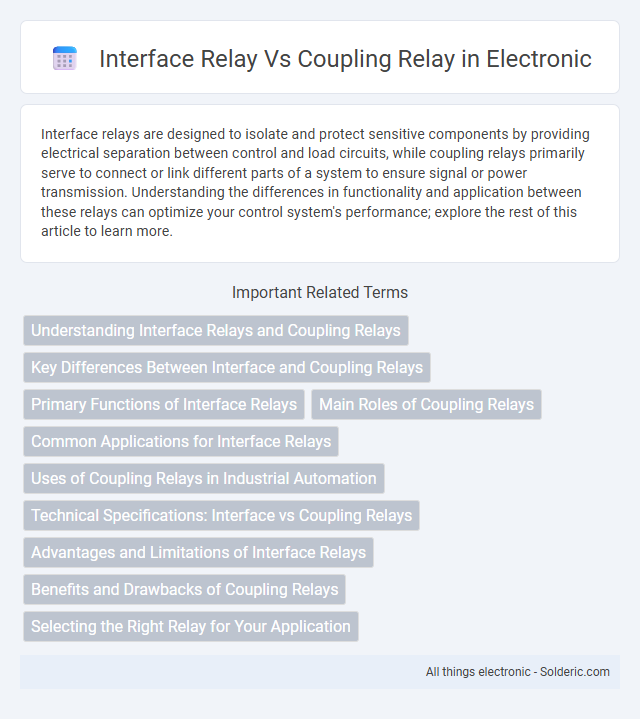Interface relays are designed to isolate and protect sensitive components by providing electrical separation between control and load circuits, while coupling relays primarily serve to connect or link different parts of a system to ensure signal or power transmission. Understanding the differences in functionality and application between these relays can optimize your control system's performance; explore the rest of this article to learn more.
Comparison Table
| Feature | Interface Relay | Coupling Relay |
|---|---|---|
| Primary Use | Signal isolation between low power and high power circuits | Connecting and transferring signals or power between circuits or systems |
| Function | Acts as a buffer or isolation barrier | Enables linkage or coupling of circuits with minimal interference |
| Typical Application | Interface between microcontrollers and higher voltage loads | Power control, switching loads in industrial automation |
| Operating Voltage | Low voltage control signals | Can handle higher power voltages |
| Isolation | High galvanic isolation to protect sensitive components | Moderate isolation depending on design |
| Switching Capacity | Low to moderate current switching | Higher current switching capability |
| Response Time | Fast response suitable for control signals | Typically slower due to mechanical coupling |
Understanding Interface Relays and Coupling Relays
Interface relays serve as isolated switches that transmit signals between different voltage levels or systems, ensuring protection and compatibility in control circuits. Coupling relays are designed to connect multiple circuit elements, enabling control signal transmission while maintaining electrical isolation and preventing interference. Your choice between these relays depends on the specific application requirements for signal isolation, voltage compatibility, and system protection.
Key Differences Between Interface and Coupling Relays
Interface relays provide electrical isolation between a control circuit and a high-power load, ensuring safe signal transmission without direct electrical connection, while coupling relays primarily serve to amplify or multiply signals between input and output circuits. Interface relays commonly feature optocouplers or transformers for isolation, whereas coupling relays use electromagnetic components to transfer signals. The key difference lies in interface relays emphasizing isolation and protection, whereas coupling relays focus on signal strength and compatibility enhancement in control systems.
Primary Functions of Interface Relays
Interface relays primarily serve to isolate and protect control circuits by providing electrical separation between low-voltage control signals and high-voltage power circuits. They enable safe switching and signal amplification, ensuring your sensitive control components remain uncompromised during operation. Unlike coupling relays that focus on connecting circuits, interface relays act as intermediaries to safeguard system integrity and enhance operational reliability.
Main Roles of Coupling Relays
Coupling relays serve as essential intermediaries that isolate control circuits from high-power loads, providing electrical separation and protection. They enable signal amplification and switching, ensuring that low-voltage control signals can safely manage higher current circuits without direct contact. Their main roles include enhancing circuit safety, preventing electrical noise interference, and facilitating the reliable operation of automated systems.
Common Applications for Interface Relays
Interface relays are commonly used in automation systems to safely isolate low-voltage control circuits from high-voltage loads, ensuring protection and signal integrity. They facilitate the interaction between microcontrollers or PLCs and heavy machinery, allowing for precise control of motors, solenoids, and industrial actuators. Typical applications include HVAC systems, conveyor control, and signal switching in manufacturing lines where electrical isolation and noise suppression are critical.
Uses of Coupling Relays in Industrial Automation
Coupling relays in industrial automation serve to isolate control circuits from high-power loads, protecting sensitive components and ensuring reliable signal transmission between devices. They enable the integration of control systems with different voltage levels and types, facilitating seamless operation of machinery and automation equipment. Your control system benefits from enhanced safety and extended equipment lifespan by using coupling relays to manage electrical interference and voltage spikes effectively.
Technical Specifications: Interface vs Coupling Relays
Interface relays are designed to handle low-level control signals and provide electrical isolation between circuits, typically featuring coil voltages from 5V to 24V and contact ratings up to 10A. Coupling relays, on the other hand, are built to transmit signals between different parts of equipment with higher load capacities, often supporting coil voltages up to 230V and contact ratings exceeding 16A for industrial applications. Your selection should consider these technical specifications to ensure compatibility with control systems and load requirements.
Advantages and Limitations of Interface Relays
Interface relays provide electrical isolation and signal amplification, enhancing control system reliability by protecting sensitive components from high voltages and currents. They simplify wiring and improve system modularity compared to coupling relays, which primarily focus on signal transmission without isolation benefits. Limitations of interface relays include slower response times and increased physical size, which may affect applications requiring rapid switching or space constraints.
Benefits and Drawbacks of Coupling Relays
Coupling relays provide electrical isolation and signal amplification between control circuits and heavy loads, enhancing system safety and reliability in automation processes. They offer fast response times and can handle high current loads, but their added components increase system complexity and potential failure points. The main drawbacks include higher cost and maintenance needs compared to simpler interface relays, making them less ideal for basic switching tasks.
Selecting the Right Relay for Your Application
Selecting the right relay hinges on the specific control and isolation requirements of your application; interface relays are ideal for providing electrical isolation between low-voltage control circuits and high-power loads, ensuring signal integrity and system protection. Coupling relays excel in linking control devices, enabling signal amplification or switching between different control voltages without direct electrical connection. Careful evaluation of load type, coil voltage, switching capacity, and response time is critical to optimize relay performance and reliability in industrial automation or electronic control systems.
interface relay vs coupling relay Infographic

 solderic.com
solderic.com